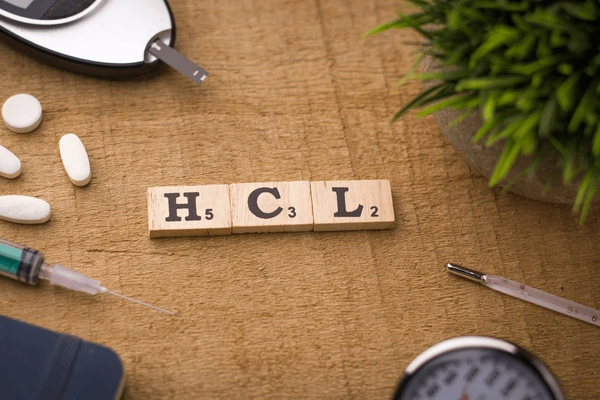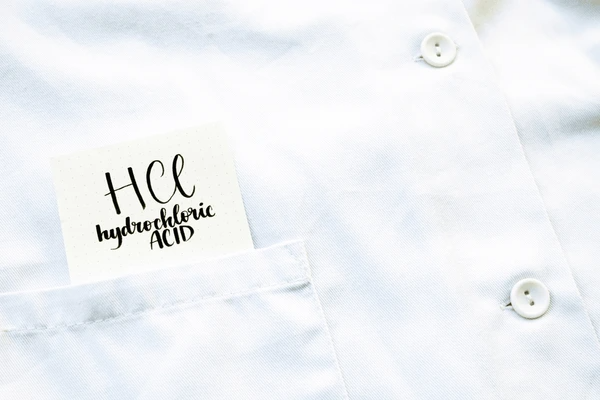
What Is Muriatic Acid?
Muriatic acid is another name for hydrochloric acid (HCl), a highly corrosive and strong acid widely used in various industrial and household applications. It is a solution of hydrogen chloride gas dissolved in water.

Compositions of Muriatic Acid
Muriatic acid is a strong inorganic acid composed of hydrogen and chlorine. Its composition can be represented by the chemical formula HCl.
Chemical Composition
Muriatic acid (HCl) is typically available as an aqueous solution, with varying concentrations ranging from dilute solutions to highly concentrated forms. The concentration is often expressed as a percentage by weight or molarity. Common concentrations include:
- 37% hydrochloric acid (12M HCl)
- 31.5% hydrochloric acid (10M HCl)
- 20% hydrochloric acid (6M HCl)
In addition to water and hydrochloric acid, muriatic acid solutions may contain trace amounts of other impurities, such as iron, sulfates, and heavy metals, depending on the manufacturing process and purity level.
Acid-Base Properties
Muriatic acid is a strong acid, meaning it dissociates completely in water to form hydronium ions (H3O+) and chloride ions (Cl-). This dissociation reaction can be represented as:
HCl + H2O → H3O+ + Cl-
The presence of hydronium ions in solution is responsible for the acidic properties of muriatic acid, including its ability to donate protons and react with bases to form salts and water.
Benefits of Muriatic Acid
- Cost-Effective: Muriatic acid is inexpensive compared to other mineral acids, making it economically viable for large-scale applications.
- Strong Acidic Nature: Its high acidity (pH ~0) makes it effective for dissolving mineral deposits, rust, and scale.
- Availability: Readily available in various concentrations for different applications.
- Environmental Considerations: When properly handled and disposed of, muriatic acid has a relatively low environmental impact compared to some other acids.
- Versatility: Muriatic acid finds diverse applications across multiple industries due to its unique properties and cost-effectiveness.
Synthesis of Muriatic Acid

Raw Materials and Synthesis Routes
It can be synthesized through various routes:
- Reaction of sodium chloride with sulfuric acid: NaCl + H2SO4 → NaHSO4 + HCl
- Oxidation of hydrogen chloride gas: 2HCl + 1/2O2 → H2O + Cl2; Cl2 + H2O → 2HCl
- Synthesis from chlorine and hydrogen gases: Cl2 + H2 → 2HCl
Industrial Production
Industrially, it is produced as a by-product of chlorination reactions, such as the synthesis of polyvinyl chloride (PVC) and isocyanates. The hydrogen chloride gas generated is absorbed in water to produce hydrochloric acid.
Purification and Concentration
Crude one contains impurities like iron, arsenic, and organic compounds. Purification involves distillation, oxidation of impurities, and treatment with hydrogen chloride gas. The acid is then concentrated by evaporation to obtain higher concentrations (up to 38% HCl).
Safety Information of Muriatic Acid
Proper safety precautions must be taken when handling or working with muriatic acid. Here are some key safety considerations:
Personal Protective Equipment (PPE)
- Wear chemical-resistant goggles or a face shield to protect eyes from splashes.
- Use acid-resistant gloves, such as nitrile or neoprene, to protect hands.
- Wear a chemical-resistant apron or protective clothing to prevent skin exposure.
- Work in a well-ventilated area or under a fume hood to avoid inhaling vapors.
Storage and Handling
- Store it in a cool, dry, and well-ventilated area, away from incompatible materials like oxidizers, metals, and bases.
- Use acid-resistant containers and ensure they are properly labeled.
- Avoid contact with skin, eyes, and clothing. Immediately flush with water if exposure occurs.
- Never add water to concentrated acid; instead, slowly add acid to water while stirring.
Spill and Disposal
- Have a spill kit readily available, including neutralizing agents like sodium bicarbonate or lime.
- In case of a spill, neutralize the acid with a base, then absorb the solution with an inert material like vermiculite or sand.
- Dispose of muriatic acid and contaminated materials according to local, state, and federal regulations.
First Aid Measures
- Eye contact: Immediately flush eyes with water for at least 15 minutes and seek medical attention.
- Skin contact: Remove contaminated clothing and rinse affected area with water for at least 15 minutes.
- Inhalation: Move to fresh air and seek medical attention if respiratory irritation persists.
- Ingestion: Do not induce vomiting. Rinse mouth with water and seek immediate medical attention.
Applications of Muriatic Acid
Industrial Applications
- Chemical Processing: It is widely used in chemical processing industries for pickling (removing oxide scales from metal surfaces), electroplating, refining mineral ores, and producing various chemicals like vinyl chloride, isocyanates, and dyes.
- Oil and Gas: It is employed in oil well acidizing to increase permeability and improve hydrocarbon flow.
- Metal Treatment: It is used for cleaning, descaling, and etching of metals during surface treatment processes.
Household and Cleaning Applications
- Toilet Bowl Cleaner: A dilute solution is commonly used as a toilet bowl cleaner due to its ability to remove mineral deposits and stains.
- Concrete Etching: It is used to etch and prepare concrete surfaces for better adhesion of coatings or overlays.
- Masonry Cleaning: It can effectively remove efflorescence, mortar smears, and mineral deposits from bricks and masonry surfaces.
Agricultural Applications
- Seed Scarification: It can be used to scarify (abrade or soften) the seed coats of certain plant species like honeylocust to improve germination rates.
- Soil Treatment: It is sometimes used to lower soil pH and increase the availability of certain nutrients for plants.
Application Cases
| Product/Project | Technical Outcomes | Application Scenarios |
|---|---|---|
| Industrial Cleaning Solutions Archer-Daniels-Midland Co. | Effective in removing oxide scales, refining mineral ores, and producing various chemicals. | Chemical processing, metal treatment, and oil well acidizing. |
| Microscale Chemical Experiment Method | Less pollution and small sample volume for determining muriatic acid. | Laboratory experiments for chemical analysis. |
| Seed Scarification Method | Effective scarification of honeylocust seeds with 20% muriatic acid. | Agricultural applications for seed treatment. |
Latest innovations of Muriatic Acid (HCl)

Modulating Uric Acid Levels
Muriatic acid and its compounds have been explored for modulating uric acid levels in the body to treat or prevent disorders related to aberrant uric acid levels, such as gout, kidney stones, and cardiovascular diseases. Novel compounds and compositions containing muriatic acid derivatives have been developed as potential therapeutic agents.
Pharmaceutical Formulations
It is used in the preparation of various pharmaceutical salts and formulations. Improved processes have been developed for synthesizing muriatic acid salts with higher purity, yield, and desirable physicochemical properties suitable for controlled-release or combination drug formulations.
Organic Synthesis
It finds applications in organic synthesis reactions, such as the preparation of guanidinoacetic acid addition compounds, amino acid-derived urea compounds, and other organic intermediates. These compounds have potential therapeutic applications or can be used as building blocks for further synthesis.
Related Topics in the World of Chemistry
Knowledge is power—especially when dealing with chemicals. Whether you’re interested in cleaning solutions or general chemical applications, our related blogs provide a wealth of information to explore.
Exploring Sodium Percarbonate: A Comprehensive Guide
Methyl Methacrylate: Properties, Uses, and Innovations Unveiled
Barium Acetate: Essential Uses, Properties and Innovations
To get detailed scientific explanations of muriatic acid, try Patsnap Eureka.

